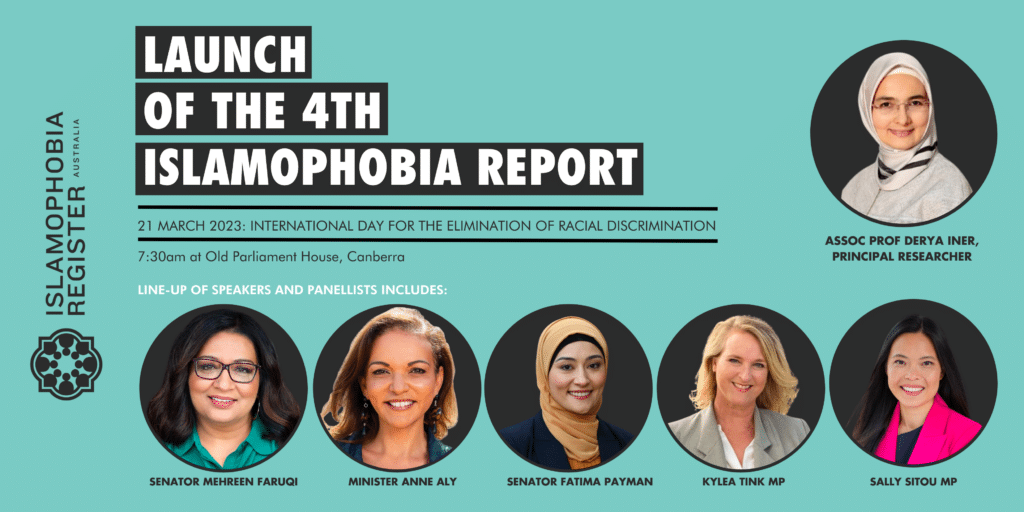There’s a gendered nature to islamophobia, and despite its prevalence in public spaces, bystanders don’t seem to be intervening to support victims, according to a new report.
Findings showed most victims of islamophobia were women (78 per cent) and most perpetrators were men (70 per cent), with two in three women being harassed by male perpetrators.
The Islamophobia Register Australia’s (‘Register’) flagship research report was released on Tuesday at an event attended by Minister for Multiculturalism Andrew Giles, Minister for Youth Anne Aly, Senator Mehreen Faruqi, Senator Fatima Payman, MP Kylea Tink and MP Sally Sitou.

The report, in partnership with Charles Sturt University and Islamic Science and Research Academy (ISRA), covers the 2020-2021 reporting period and compiles all incident data from the inception of the Register in September 2014 until December 2021, including 930 verified incidents of islamophobia (515 offline and 415 online).
Since the inception of the Register (2014-15) until the start of the Covid-19 era (2020-21), there’s been a concerning fall in witness reporting of islamophobia which dropped by about half (from 47 per cent to 24 per cent), according to the report.
Principal Researcher and CSU Associate Professor Dr. Derya Iner says the islamophobic incidents in the report “were mostly committed by men perceived to be from Anglo/European backgrounds and from older cohorts” with the victims being “mostly younger hijabi women from non-White ethnic backgrounds and from vulnerable cohorts, unaccompanied or with children”.
Dr. Iner says these significant characteristics of islamophobia have been seen repeatedly over the eight years of reported incidents and that incidents in guarded places reached up to 70 per cent in the last reporting period.
“If we don’t want to keep repeating these numbers in the next 8 years, it is time to ask ourselves ‘what can we do to stop it?’ and ‘How can we dismantle gender, race and age enablers reproducing islamophobia?’”, says Dr. Iner.
Over the 8 year period of the recent report, verbal intimidation was the most common form of abuse (45 per cent) followed by graffiti and vandalism (12 per cent) and discrimination by authorities in official buildings, workplaces, schools (10 per cent), written material (9 per cent), physical assault (8 per cent), multiple incident types in one case (8 per cent), non-verbal intimidation (6 per cent) and other (2 per cent).
In online circumstances, it was found that three quarters (75 per cent) of reporters in the period of 2014- 21 were Muslim. The ratio of non-Muslim reporters dropped significantly (from 35 per cent in 2014-15 to 2 per cent in 2020-21).
Executive Director of Islamophobia Register Australia Sharara Attai says, “it’s clear from this report that there is an urgent need to activate bystanders, both in the real world and online.”
“What’s also troubling is that this report reinforces the fact that Islamophobia disproportionately affects Muslim women. We need government action to ensure greater safeguards for Muslims in Australia,” she says.
Deputy Leader of the Australian Greens, Senator Mehreen Faruqi echoes this call for greater government action against islamophobia saying “The extent of racism and hatred that Muslims in Australia face remains deeply concerning.”
“For too long, Muslim women and children have borne the brunt of Islamophobia, often suffering long-term emotional harm.”
Senator Faruqui adds that “the previous Coalition Government fuelled Islamophobia then sat back and did nothing” and that Labor “must commit to concrete responses”.
The first hijab-wearing Senator in Australia, Senator Fatima Payman labelled the Register’s report “confronting” but says she’s “optimistic this data will help our nation fight against this discrimination”.
“I encourage anyone who experiences Islamophobia to take a stand and report the incident,” she says.


